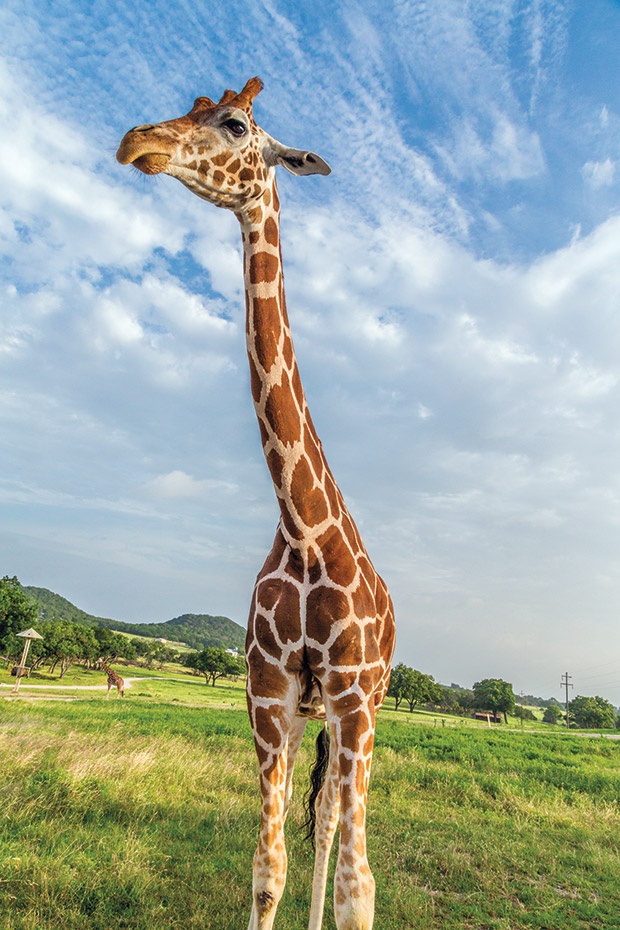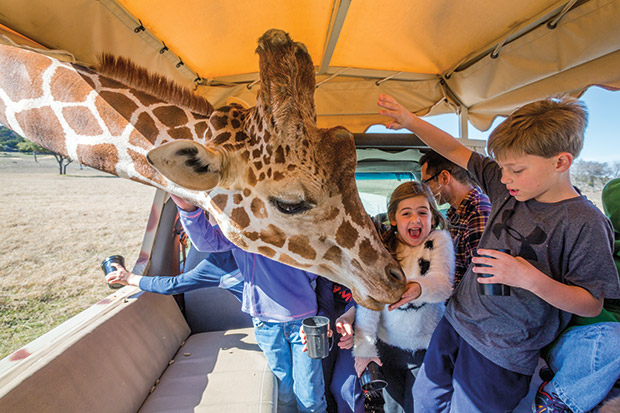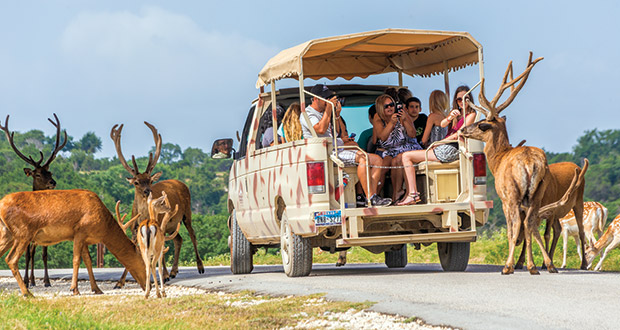
Sure, it’s fun to hand-feed giraffes through the sunroof, but there are other important reasons why Texas drive-through wildlife parks matter.
Wildlife Ranches
Following is contact information for the wildlife ranches and other attractions mentioned in the story. Contact each ranch for details on hours, admission fees, tours, lodging, special camps, programs, and events. For area information, go to www.glenrosetexas.net, www.innewbraunfels.com, and www.visitsanantonio.com.
Fossil Rim Wildlife Center is at 2299 County Road 2008 in Glen Rose, 254/897-2960.
Dinosaur Valley State Park is at 1629 Park Rd. 59 in Glen Rose, 254/897-4588.
Oakdale Park is at 1019 NE Barnard St. in Glen Rose, 254/897-2321.
Natural Bridge Wildlife Ranch is at 26515 Natural Bridge Caverns Rd., between San Antonio and New Braunfels. Call 830/438-7400.
In the spirit of outdoor adventure, I wanted to kick off summer vacation with an experience that connected our kids to the ruggedly beautiful Texas landscape, so we hit the road on the last day of school, right after the final bell. Our Subaru was packed with road-trip essentials—snacks, sunscreen, and swimsuits—as we headed north from Austin on US 183 for our first visit to Glen Rose.
Known as the “Dinosaur Capital of Texas,” Glen Rose has long been considered a great family destination (particularly for those with Brontosaurus-obsessed kids). Millions of years ago, an expansive sea covered the region. When the water receded it left a lush terrain and, over time, fossilized impressions that tell the story of its early beginnings (nearby Dinosaur Valley State Park boasts some of the best-preserved dinosaur tracks in the country). With an abundance of hiking and mountain-bike trails, canoeing and tubing, camping, and swimming, Glen Rose is also a mecca for outdoors enthusiasts.
But on this trip we’re seeking something wilder than sauropod tracks: Fossil Rim Wildlife Center, home to approximately 1,100 animals (more than half of them in the threatened or endangered categories) that roam freely on the preserve’s 1,800 acres. The park offers drive-through and guided tours that allow visitors to get close to natives like white-tailed deer, wild turkeys, and roadrunners, plus show-stealing exotics like gemsbok (their distinctive facial marking inspired African tribal masks), chestnut-colored bongos (the largest variety of forest antelope), and wildebeest. Beyond the thrill of Instagram moments with zebras and the chance to fling snacks to American bison or aoudad, the most extraordinary thing about Fossil Rim is its commitment to the preservation and restoration of wildlife and natural habitats.
“What sets us apart from other parks is that our animals are raised in groups, flocks, and herds, so eventually we’re able to reintroduce them to natural habitats and they retain that social behavior,” explains Warren Lewis, director of marketing for Fossil Rim. The park’s expansive property makes that work possible. “We have about one acre for each animal,” Warren adds proudly.
Fossil Rim focuses on species survival and recovery by managing carefully selected species in conditions that allow for their natural behaviors. When these animals produce offspring, they’re available for reintroduction and recovery programs around the world.
For instance, Fossil Rim is currently the most prolific breeder of cheetah in North America (18 cubs were born in the last 12 months). And the park’s team is currently working with the Sahara Conservation Fund to build a “world herd” of scimitar-horned oryx in Abu Dhabi (the species has been extinct in the wild since 1999). In the coming months, the park will ship around 50 animals there every three to six months, where they’ll remain in a large holding area, until they have 500. Once the herd stabilizes, they’ll be shipped to Chad and released in the wild.
Another example of a highly endangered species that Fossil Rim is replenishing is the Attwater’s prairie chicken, a native of the Gulf Coast regions of Texas and Louisiana. The striking black and white bird with a bright yellow head is known for its springtime courtship dance. “We currently hold about 54 percent of their population,” Warren tells me. “Each year we send around 400 of them to a refuge in Eagle Lake, near Sealy. We’re actually close to creating a sustainable population.”
In other words, Fossil Rim’s residents provide an insurance population, so that when bad things happen elsewhere they can prevent species from becoming truly extinct. The most sensitive examples, like Attwater’s prairie chicken, the Mexican gray wolf, and southern black rhino, are kept in the Jim Jackson Intensive Management Area. To minimize disruption, it’s only accessible on guided tours (advance reservations required).

When we arrived at Fossil Rim, we purchased a few bags of feed ($10 each) and set out on the 9.5-mile Scenic Wildlife Drive, the most common way to experience the park. Our kids immediately focused on the fun: Following the example of cars in front of us, we allowed them to ride standing up, with heads popping through the sunroof (no seat belts, a definite family first!) as we drove slowly along the dusty road. We encountered animals immediately, and everywhere. A cluster of oak trees provided a shady spot to feed giraffes by hand (“Their tongues are black!” my son shouted at his sister, who was laughing in the backseat), and we snapped close-ups of zebras and a strapping axis buck.
Incidentally, giraffes are the only animals that you’re allowed to feed by hand (for all others, you toss the pellets from your car window), although some may try to convince you otherwise. Make no mistake: Fossil Rim’s residents have figured out that cars equal an endless buffet. I wouldn’t keep a bag of Cheetos on the center console, for instance, when an ostrich or emu comes poking around, lest you want a long neck extended across your lap. (Emus are gentle and curious, Warren assures me, while ostriches are more aggressive and motivated by food.)
When we reached the Overlook, Fossil Rim’s highest scenic viewpoint, we were ready to stretch our legs and have lunch. Overlook Café serves a simple menu of burgers and wrap sandwiches, along with spectacular views of the juniper, red oaks, cedar elms, and prickly pear cactus that color the surrounding hillsides. We sat outside on the deck, nibbling fries and sipping cold drinks as we enjoyed the simple pleasure of a day together with the warm afternoon sun on our backs. Afterwards, we walked to the Children’s Animal Center to make a few friends. We brushed down an obviously pampered and very obliging pygmy goat, watched a wandering pot-bellied pig and a massive 120-pound African spurred tortoise, and examined an 80-pound rhino skull. Along the way, we read trail markers to identify plants like bluebonnets and blue salvia that are integral to the plateau’s ecosystem. Since no road trip is complete without a souvenir, we also hit the Nature Store and left with pink giraffe headbands and a plush toy wolf. Proceeds from many of the gifts (including art, jewelry, books, and toys) support indigenous peoples.
After our full and dusty day, we were ready to cool down. Luckily, we’d booked our accommodations based on the awesomeness of its pool. Oakdale Park is a well-kept retro motor inn and campsite and home to the “Oakdale Plunge,” one of the oldest pools in Texas (it was dug in 1925 by horse and mule teams!). After we settled into “Ferndale,” a cute stone cottage with vintage guitars hung over the two beds, we grabbed towels and hit the water. With a high-spraying fountain in the center of the pool, zippy water slide, ’80s rock blasting from overhead speakers, and countless cannon balls off the diving board—it felt like we were splashing into summer in just the right way. And it occurred to me that my husband and I were savoring the fun as much as our kids.
There are plenty of restaurants in the area, but we’d chosen to bring a cooler and make the most of our cabin experience. After a picnic dinner, we crossed the road to climb the giant boulders alongside the rushing Paluxy River and watch the last of the light fade over Big Rocks Park.
The next time we visit Fossil Rim, we plan to deepen the experience by settling in for the night. Fossil Rim has its own lodging in the form of comfortable, safari-style tented cabins. The park also offers special events like photography workshops, the behind-the-scenes “Animal Keeper” tour, and “Discover After Dark,” an evening excursion that allows guests to venture out using spotlights with special red lenses to view nocturnal wildlife like owls and long-haired rabbits.

Closer to our Austin home And just off I-35, between San Antonio and New Braunfels, Natural Bridge Wildlife Ranch calls itself a “Texas-style African safari.” For good reason: Driving through its
400 acres, past playful ring-tailed lemurs and a mud-caked white rhinoceros, definitely feels like an exotic world apart from the often-congested interstate a few miles east.
Last fall, I toured the park with Tiffany Soechting, the ranch’s animal specialist and marketing director, and learned the operation is a family affair. Tiffany started working at NBWR in 1985, a year after it opened, and eventually married the son of the owners. The couple, along with Tiffany’s brother-in-law and sister-in-law, went on to raise their children on the property, which gave them a pretty awesome yard to frolic in. (“It can be pretty funny giving out dinner party directions to our house,” Tiffany confessed.)
Natural Bridge is the longest-running wildlife park in Texas, and the most visited, but it has continuously evolved to keep visitors (many of them season-pass holders) engaged. In the last 10 years it has expanded the Petting Barnyard, Lemur Island (a habitat for ring-tailed lemurs), The Trading Post gift shop, and the Safari Camp Grill (which serves burgers, salads, nachos, and homemade salsa and guacamole). As we bounced across creek beds and cattle guards, and past ponds where fallow deer had gathered to drink, Tiffany identified several examples of the 40 species of exotic, native, and endangered residents.
The park’s newest section, Tower Creek, was recently created in an area of the property that had not been developed. “It’s so scenic down there,” Tiffany says, “and it created a tranquil area for giraffes, sable antelope, and Nile lechwe to grow their own separate herds.”
My tour ended at the giraffe barn, which is actually front-and-center at the entrance, but Tiffany had saved their most famous residents—two rare twin reticulated giraffes—for last. Wasswa and Nakato (aka Buddy) were born at the ranch in May 2013. The birth was picked up by CNN and watched around the world, and a couple of stars were born. As a result, Natural Bridge recently launched their Giraffe Ambassador Program, a monthly educational workshop that’s meant to encourage support and care for the world’s tallest mammal. Each participant receives a field journal, T-shirt, and certificates as well as an opportunity to interact with Buddy. (Sadly, Wasswa died suddenly this winter from a rare illness.) A portion of the program fee ($30) funds giraffe research in Africa. Tiffany admits that the class, held at “Longneck Learning Center,” was originally geared to kids, but a growing number of adults have enrolled.
“After the twins were born we started to learn how vulnerable giraffes are in the wild,” says Tiffany. “In the 1970s, there were about 400,000 in the world, and today there are only about 80,000. If something isn’t done now and current trends continue, giraffe populations will be extinct in the wild within the next 10 years. This program is our first step in raising awareness.” The monthly program will culminate with the first annual Texas Giraffe Day on May 10 (see their website for details).
Tiffany hopes that the school tours, interactive discovery programs, and the special nose-to-nose moments that Natural Bridge provides will leave a lasting impression. “We sneak in the education, even if it’s just the memories our visitors take with them. When an animal is right in your face, you have an experience that you talk about forever; and it creates a connection to all animals. ”
At the heart of both Fossil Rim and Natural Bridge Wildlife Ranch is education—raising awareness of the diversity of animal and plant species essential to the planet’s sustainability. Spring, the season of rebirth, is a particularly exciting time to visit both parks for obvious reasons: blooms and babies. If you’re lucky, you might even witness something profound, like the birth of a new resident. At a time when dwindling natural resources face a serious threat, wildlife parks provide a vital connection to our natural heritage, and foster an understanding of how we can help protect its precious diversity. And it feels good to make the time to step out of your life and take it all in.








